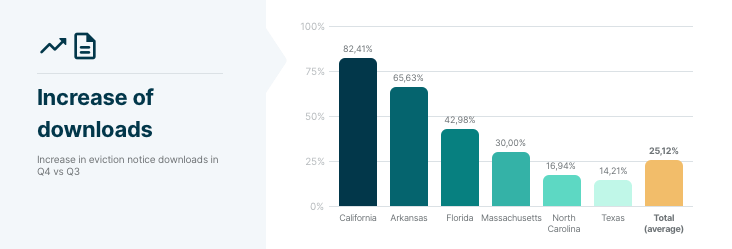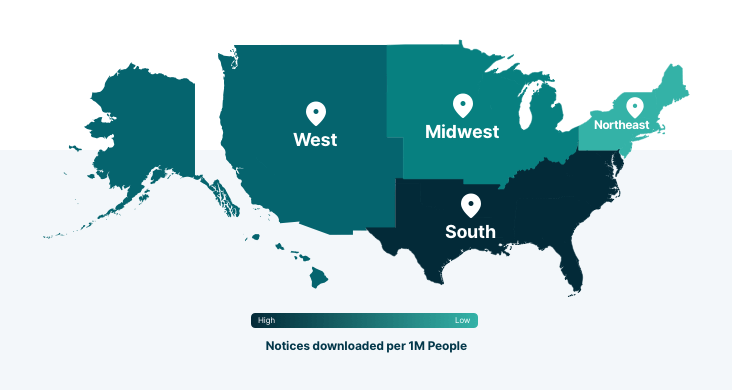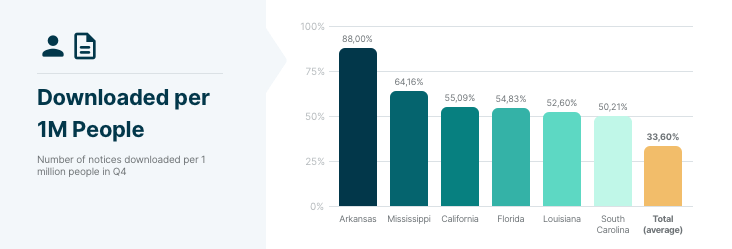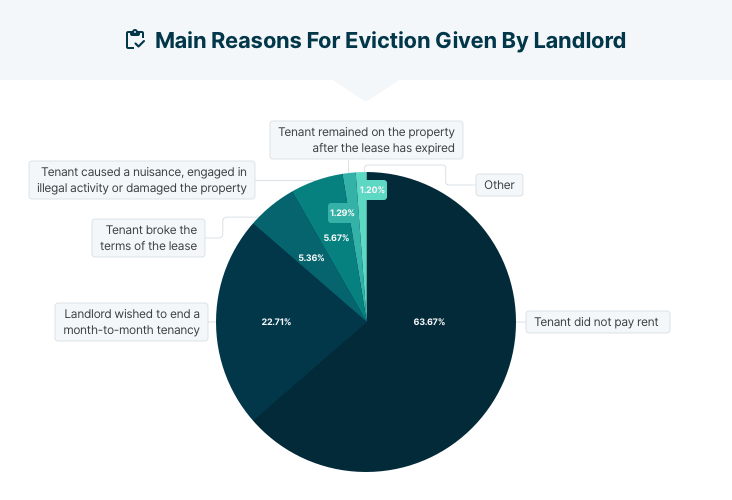On August 26, 2021, the Supreme Court ended the Center for Disease Control and Prevention’s COVID-19 eviction ban. This federal moratorium on evictions was initially enacted to facilitate social distancing and help prevent the spread of COVID-19.
Since the termination of the ban, eviction rates within the U.S. have soared throughout a variety of states, increasing by over 40% in a number of cities where eviction bans have ended.
In parallel, in the last quarter of 2021, we’ve seen a 25% increase in downloads of our eviction notice templates in comparison to the three months before the moratorium ended. There was also a 14% increase in Q4 compared to the same period in 2020.
This growth in website traffic has provided LawDistrict with an influx of new data on eviction rates and the extent to which they’ve risen due to the end of the federal eviction moratorium. While Eviction Lab has tracked this upwards trend in a very limited number of states and cities, our database spans almost all U.S. states.
By coupling this information with research from across the web, we’ve obtained the following findings:
Keep reading to explore our data-backed insights about the COVID-19 eviction crisis across the U.S.
Evictions Significantly Increased after the End of Federal and State Moratoriums
The latest data from Princeton University’s Eviction Lab reveals that eviction filings have been rising in most of the cities and states they are monitoring. Namely, filings increased 10.4% from the first half of August to mid-September, and in the first half of October, numbers were 38% above August levels.
These upwards shifts came directly after the end of the federal eviction moratorium in August and state-wide bans ending in June and July in states such as Connecticut, Minnesota, and Delaware.
Our data similarly revealed a 25% increase in eviction notice template downloads within the last three months of 2021 compared to the three months prior to the end of the moratorium.
Some experts believe that part of the increase is due to courts catching up on eviction case backlogs, but the lack of federal emergency rental assistance and rising house prices may also be playing a role.
Eviction filing numbers are expected to further increase and return to pre-pandemic levels as processing delays begin to decrease.
The marked increase of emergency rental assistance (ERA) in the summer of 2021 may also be deterring files. The Treasury Department reported that both local and state ERA programs distributed approximately $1.6 billion in June of this year.
Eviction Rates Increased the Most in Highly Populated States
In two of the three most populated states, California and Florida, eviction notice downloads rose by a much higher degree, increasing by 82% and 43% respectively. Conversely, rates in Texas only grew by 14%.
In addition, these three densely populated states amount to 42.9% of eviction notice downloads, while they only make up 27% of the population.

Eviction Rates Are Highest in Southern States
Our data reveals that eviction notices are highest in the South, with 41 eviction notices being downloaded per 1,000,000 people. This amounts to a total of 5,182 eviction notices between September and November of this year.
In comparison, there were only 27 eviction notices per 1000 people in Western states (3,095) and 27 evictions per 1,000 people (1,867) in the Midwest within the same period.
In Northeastern states, only 17 people of every 1,000 (994) downloaded an eviction notice.

The states with the highest amount of eviction notice downloads per household were:
- Arkansas
- Mississippi
- California
- Florida
- Louisiana

The Most Common Reason for Eviction: Unpaid Rent
The COVID-19 pandemic has had far-reaching negative consequences on the ability of many citizens to pay their bills, including rent. Studies have shown that 15.4% of U.S. renters are behind on recent rent payments.
When surveyed, 45.1% of these renters say that it’s very or somewhat likely that they will be evicted within the next two months. With most state eviction moratoriums expiring, landlords can begin the early stages of eviction as soon as a tenant misses just one payment.
By compiling data from a variety of states, we found that a tenant not paying rent is the most common reason for eviction, cited in 63.67% of eviction cases.
Other studies also show that, on average, renters are behind three months’ rent and owe $2,550.
In addition, data found that the second most common eviction reason was the ending of a month-to-month tenancy in both California and Texas. On the other hand, the second-most common frequent reason for eviction in Florida was the tenant engaging in illegal activity.

How the “Keeping Renters Safe Act” May Help
COVID-19 and new variants such as Delta or Omicron have continued to stifle businesses and delay a full recovery of the U.S. economy.
Although the CARES Act provides some support to families through unemployment insurance and stimulus payments, it’s expected to be insufficient in preventing an eviction surge following the end of the federal moratorium.
In addition, as state-specific eviction moratoria eventually come to an end, millions of renters will owe large amounts of back rent.
The Keeping Renters Safe Act of 2021 is intended to help people remain safely housed, in an effort to mitigate the ongoing public health crisis and avoid causing further economic harm to families.
Although it’s unsure whether the act will gather enough support in Congress to pass. Its goal is to protect renters from eviction and reduce the spread of COVID-19 by amending section 361 of the Public Health Service Act.
This will provide the Department of Health and Human Services (HHS) with permanent authority to implement federal eviction moratoriums to address public health crises. The act will also direct the HHS to establish a national residential eviction moratorium as a response to COVID-19.






